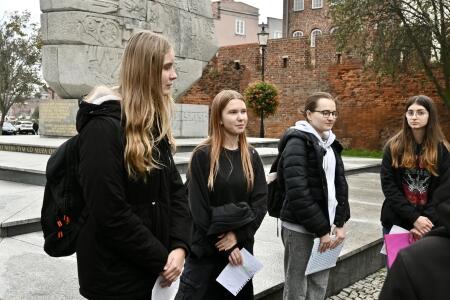80-136 Gdańsk
ul. Kartuska 128

[English]
Our class walk in the footsteps of the Teutonic Knights in Gdańsk as part of the lesson"Gdańsk on tongues" organized by Marta Kalisz, Patrycja Wnuk, Michalina Grobelna andNatalia Kaczmarek from class IIIA was an exceptional history lesson, bringing closer theinfluence of the Teutonic Order on the fate of the city and its inhabitants. During the walk, we explored the history of Gdańsk, discovering how the Teutonic Knights shaped its development and architecture. The walk allowed us to understand the significance of events that, despite the passing of centuries, have had an influence on the city that is still visible to this day. We started with a monument commemorating innocent residents who died during the massacre of the people of Gdańsk. We learned about the betrayal of the Teutonic Knights and the brutal attack on the city that initiated the fights with the Order. Our next stop was the grounds of the former Teutonic castle, which was built in the 14th century and was surrounded by walls, a moat and towers, from which the Swan Tower was used to watch the port. The castle was destroyed in 1454 during the Thirteen Years' War. We then visited the Great Mill, a former industrial plant that processed grain for local consumption and export. Next to it was the Radunia Canal, built by the Teutonic Knights to supply the city with water and power the mills. A further walk took us to Osiek, a historic fishing district, where most of the buildings were destroyed in 1945. Finally, we visited Ołowianka Island, a former Teutonic Knights' estate, a key trading and storage location. The walk was filled with historical tales and showed us the rich past of Gdańsk.
[Français]
Notre sortie scolaire sur les traces des Chevaliers Teutoniques à Gdansk, organisée par Marta Kalisz, Patrycja Wnuk, Michalina Grobelna et Natalia Kaczmarek qu'on a faite dans le cadre du projet « Gdańsk, on en parle », était une leçon d'histoire exceptionnelle. Nous avons pu découvrir l'influence de l'ordre des Chevaliers Teutoniques sur la ville et ses habitants. Cette excursion nous a permis d’explorer l’histoire de Gdańsk et de voir comment les Teutoniques ont contribué à son développement et à son architecture. On a compris l’importance des événements historiques qui, même après des siècles, se reflètent encore dans le caractère de la ville. Nous avons commencé par un monument des habitants innocents qui ont perdu la vie lors du massacre de Gdańsk. Nous avons appris la trahison des Teutoniques et leur attaque brutale sur la ville, ce qui a lancé les combats contre l'Ordre. Ensuite, nous avons visité le site de l'ancien château des Chevaliers Teutoniques construit au XIVe siècle. Il était entouré de murs, de fossé et de tours. La tour « Le Cygne » a été utilisée pour observer le port. Le château a été détruit en 1454 pendant la guerre de treize ans. Puis, nous avons vu le Grand Moulin qui était à la fois moulin à eau, grenier et boulangerie. À côté, il y avait le canal de Radunia, construit par les Teutoniques pour approvisionner la ville en eau et alimenter les moulins. Ensuite, nous sommes arrivés à Osiek, le quartier de pêche historique, dont la plupart des bâtiments ont été détruits en 1945.
Enfin, nous avons visité l’île Ołowianka, autrefois la propriété des Teutoniques, qui était un lieu clé pour le commerce et les entrepôts. Cette excursion nous a permis de découvrir une riche histoire de Gdańsk.
[Deutsch]
Unser Klassenspaziergang über den Deutschen Orden in Danzig während des Unterrichts „Danzig in den Sprachen“, organisiert von Marta Kalisz, Patrycja Wnuk, Michalina Grobelna und Natalia Kaczmarek aus der Klasse IIIA, war eine einzigartige Geschichtsstunde. Die Schülerinnen haben den Einfluss des Deutschen Ordens über das Schicksal der Stadt und ihrer Bewohner übersetzt. Während des Spaziergangs haben sie über die reiche Geschichte von Danzig und deutsche Architektur erzählen. Der Spaziergang hat uns die Bedeutung von historischen Ereignissen zu verstehen erlaubt, die trotz der Jahrhunderte noch immer im historischen Charakter der Stadt sichtbar sind. Wir haben mit einem Denkmal begonnen. Dieses Denkmal erinnert an die Unschuldigen, die während des Massakers an der Danziger Bevölkerung ihr Leben ließen. Wir haben von dem Verrat des Deutschen Ordens und dem Angriff auf die Stadt erfahren. Dies war der Beginn des Kampfes gegen den Deutschen Orden. Der nächste Platz war der Bereich der Kreuzritterburg, die im 14. Jahrhundert erbaut wurde und von Mauern, einem Wassergraben und Türmen umgeben war. Der Schwanenturm hat zur Beobachtung des Hafens gedient. Die Burg wurde 1454 während des Dreizehnjährigen Krieges zerstört. Danach haben wir die Große Mühle besichtigt, eine ehemalige Industrieanlage. Die Mühle hat den lokalen Bedarf und den Export befriedigt. Daneben fließt der Radunia-Kanal, der die Stadt mit Wasser versorgte. Schließlich haben wir Osiek, das alte Fischerviertel und die Insel Ołowianka gesehen. Der Spaziergang war voller Geschichte. Er hat uns die reiche Vergangenheit Danzigs gezeigt.


80-136 Gdańsk
ul. Kartuska 128
